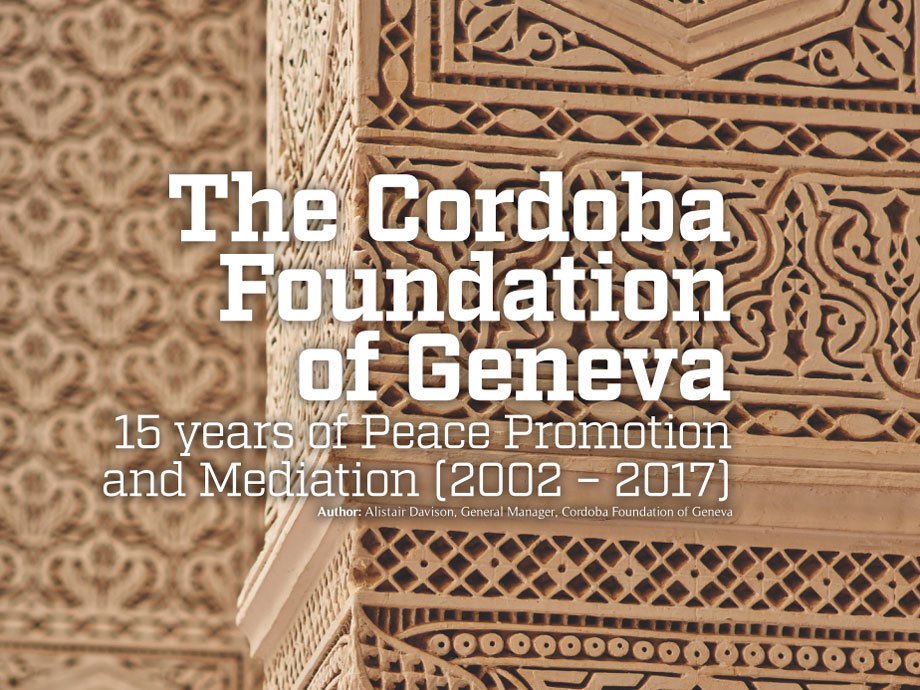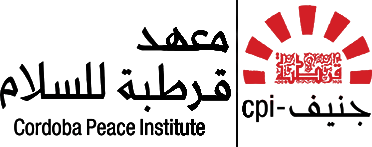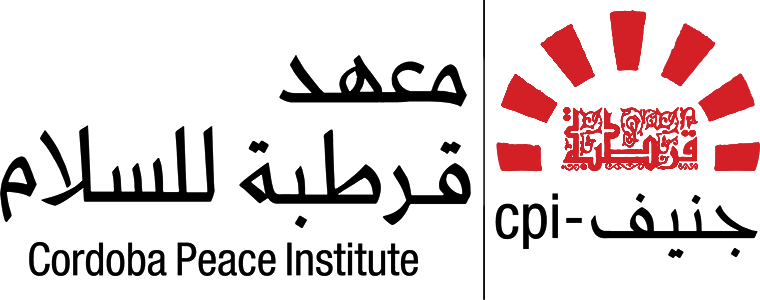The Cordoba Update, January – February 2018

Dear Reader,
Over fifteen years, the CFG has worked in Europe and the Arab and Muslim worlds, developing an impressive network of contacts influential in local religious and civil society. With the trust it enjoys with these partners, the Foundation can act as a bridge and facilitator, engaging with marginalised actors excluded from peace processes, and who sometimes have difficulty interacting directly with governments because of their very different perspectives. This privileged access would not be possible without the CFG’s strong cultural sensitivity, and core values of non-violence, inclusivity, impartiality, empathy and independence. In addition, its methodology gathers parties who might not ordinarily interact in “safe mediation spaces,” to work on jointly-implemented projects, to build trust and diminish mutual suspicion, using the concept of diapraxis – dialogue through practice.
Since 2010, the Foundation’s main programs focus on the impact of ideological polarisations in North Africa, sectarian divisions in the Middle East, a variety of ethnic and religious tensions across the Sahel region, and on preventing violence and extremism across these three regions.
In this “Cordoba Update” you will find two contributions. Alistair Davison relays the history, identity and unique value of the CFG, in an article first published in the Geneva-based Klvin Magazine. Abbas Aroua introduces the Foundation’s latest publication “Addressing Extremism and Violence: The Importance of Terminology,” which advocates a nuanced understanding of the terminology of violent extremism and how this helps in understanding and tackling processes that lead to extremism.

News of the Foundation
Past Events
Zanzibar – Training for Zanzibari scholars and journalists in conflict transformation, conflict analysis, and peace journalism, in collaboration with the Office of the Grand Mufti of Zanzibar, 13-20 November 2017.
Morocco – Training for Moroccan university students in the approaches to conflict transformation and the tools of conflict analysis, and in concepts of Early Warning, Rapid Response mechanisms, in collaboration with Mada Centre, 16-17 December 2017.
Lebanon – Field mission and follow-up of the activities of the Lebanese Forum of Humanitarian Associations, 8-12 January 2018.
PVE Round Table – Contribution to a round table on the theme: “Investing in Peace and Prevention to Face Violent Extremism” organized in the Maison de la Paix, Geneva, on 25 January 2018.
Chad – Training of Trainers for the Chadian Peace Network, in conflict transformation and mediation, in collaboration with the Culture and Religion in Mediation program (CARIM) of the ETH Zurich, 28-31 January 2018.
 |
The Cordoba Foundation of Geneva: 15 years of Peace Promotion and Mediation (2002 – 2017)by Alistair Davison, General Manager, Cordoba Foundation of Geneva |
October 2017
The original version of this article was published in Klvin Magazine: http://www.klvinmag.com/
A multitude of leather-bound Arabic tomes rise from floor to ceiling at the Cordoba Foundation of Geneva’s discreet offices at Chemin des Vignes. “It’s probably the most diverse Arabic library in Geneva, says Director Abbas Aroua, “and a tranquil place to resource ourselves for our work in many difficult conflict situations”.
It is from these offices, in walking distance of “Genève Internationale”, that the Cordoba Foundation of Geneva (CFG) carries out its work in peace promotion, mediation and conflict transformation. The library was bequeathed by founding board member Shaikh Mahmoud Bouzouzou, a pioneer of the Algerian nationalist movement and much-respected theologian, Islamologue, journalist and mediator. It is also now a great source of literature and studies on mediation and conflict, interspersed with the works of Simone de Beauvoir, Jean-Paul Sartre and other great European writers and philosophers.
Over the past fifteen years, the CFG has worked to bring together Islamists and secularists across North Africa, Copts and Muslims in Egypt, Salafists and Sufis across the Sahel. It helped mediate between the Danish government and Muslim organisations following the “Cartoons of Mohamed” crisis and supported the Swiss government in working with Swiss Muslims to defuse tensions following the anti-minaret vote.
The foundation was established in 2002, and its name links Cordoba, the Andalusian city renowned as a medieval centre of inter-faith cultural, intellectual and linguistic exchange, with Geneva, centre of so much international mediation and humanitarian exchange today. From the outset, its focus has been on countries with Muslim majorities, as well as those where tensions arise over the integration and acceptance of Muslim communities.
Since 2010, the foundation’s main programs have been carried out in partnership with the Religion, Politics and Conflict Desk of the Swiss Federal Department of Foreign Affairs, with the support of other donors, and focus on various lines of tension: the impact of different world views in North Africa, sectarian tensions in the Middle East, and a variety of ethnic, tribal and religious tensions across the Sahel region. There are also important projects with respected Islamic scholars across these regions to address the issues of extremism and violence through proper interpretations of Islamic texts and jurisprudence.
One of the core principles of the CFG is its independence, and this has enabled it to build confidence across the Arab and Muslim world with an impressive network of contacts, who give access to influential local religious and civil society actors marginalised or excluded from peace processes, and who sometimes have difficulty interacting directly with governments as a result of their very different viewpoints. Due to the trust it enjoys with its partners in these regions, the CFG is able to act as a bridge and facilitator. This privileged access would not be possible without the success of its methodology of “diapraxis” which brings together parties who might not naturally speak to one another to work on jointly-implemented projects, in order to build trust and break down prejudices and mutual suspicion. The approach is built on the idea that “you don’t have to have the same reasons for doing something together, as long as the intentions are compatible, and you can go in the same direction.”
The focus on the Islamic context is deliberate and well founded, as explained by Lakhdar Ghettas, Senior Program Officer: “Following the devastating wars of the 20th Century, and the desperate situation in which Europe found itself after World War Two, there was a real determination that such wars should never happen again. This gave rise in Europe to the whole science of peace and conflict studies, and the development of tools and techniques for mediation and conflict transformation to ensure that, while conflict is a normal and necessary part of life, violence in conflict can be avoided and must be an absolute last resort. Such a development has not happened in countries with Muslim majorities, and the shortage of suitable tools for dealing with conflict has contributed to the horrendous violence we see today in so many conflicts across the Middle East, North Africa and the Sahel region, areas which are the focus of most of our work.”
The foundation has a small and dedicated team of full-time staff in Geneva and the field, with a variety of backgrounds and experience including conflict studies, political science, journalism, languages and Islamic philosophy, together with a large and talented pool of consultants and researchers throughout the regions where it works. But the most important quality in this work is a passion for peace building in a challenging environment.
Geneva is also part of the identity of the CFG, and for Charlotte Mounier, Program Associate: “Our base in Geneva is definitely an advantage. Although the focus of our work is generally abroad, Switzerland’s non-colonial past, and Geneva’s international reputation as the home of numerous NGOs and international organizations helps with our credibility and the trust people place in us as an honest broker.”
Thanks to the generous support of the Genevan communes of Lancy, Onex and Plan-les-Ouates, the CFG is also connected locally. Their donations have enabled the foundation to carry out work on rising xenophobia in Hungary, training on conflict transformation in Libya and a peace journalism project in Mauritania.
Through its networks, and the regional platforms it runs for each of its major programs, the CFG receives constant requests for assistance, training and mediation. “There is so much that could be done, and we are really hampered by the lack of financial resources available for this sensitive kind of work, at a time of such turmoil. The nature of fundraising is in mutation, and we are looking towards new sources of support”, says Project Officer Sarah Franck, responsible for the recent launch of the foundation’s donations campaign, which can be found on its website: www.cordoue.ch
While “innovation” may be the new mantra at the CFG, the team stays connected with the heritage of the past, and the library is a constant reminder of the richness and diversity of that heritage, “I wish I could claim to have read even a tenth of the marvelous collection of books that surrounds us here at the Foundation” says Abbas Aroua, “but ongoing political developments keep us busy!” Let’s hope that the work of the CFG will lead to a more peaceful world and allow time for the wisdom in those books to be read and shared among people of different cultures, as it was in medieval Cordoba.
{/slider}
 |
Preventing Extremism and ViolenceAddressing Violence and Extremism: The Importance of Terminologyby Abbas Aroua, Director, Cordoba Foundation of Geneva |
January 2018
A longer version of this paper in English, with references and illustrations, is available online at:
https://www.cordoue.ch/publications-mega/research-papers/727
In recent years, “countering/combatting violent extremism” (CVE) or “preventing violent extremism” (PVE) has become a must in most peace building programs. Yet, the fast-growing interest in this topic belies the fundamental problem of the lack of a clear and broadly accepted definition of the VE concept. This article aims to contribute to a more accurate definition of the terms used in the context of extremism and violence, to attempt a descriptive model of the extremization process, and to discuss the various approaches to de-extremization.
Extremism is not a “standalone” concept and has to be defined relative to a commonly agreed reference (a convention). In natural and social sciences, a normal standard distribution is represented graphically by a bell curve with a maximum at the median and a minimum at the two tails, which indicate the high and the low extremes relative to the median value. Within a community, the extreme may be viewed as a divergence from the norm accepted by the majority. Therefore, what is extreme depends on the context in which the norm is established. The median used as a reference may relate to norms set within the framework of national, international, community, or religious law. The high extreme represents excess and transgression of the norm. The low extreme is characterized by resignation from public action. The median is about acting without either transgression or resignation.
The term “radicalism” is frequently used in a pejorative sense in discussions relating to VE. Radicalism is related to “radical” which derives from the Latin radix meaning root. Political radicalism refers to the opinions and behaviour of people who advocate political changes at the root. Religious radicalism is about returning to the root, i.e. to an understanding and a practice of religion that comply with the religious sources as interpreted and lived by the early believers. It is therefore about orthodoxy and orthopraxy.
Violence is “actions, words, attitudes, structures or systems that cause physical, psychological, social or environmental damage and/or prevent people from reaching their full human potential.” (Fisher et al. Working with Conflict. Zed Books & Responding to Conflict, 2000). The position with respect to direct violence, that may take the form of armed struggle, is usually based on three parameters: legitimacy, lawfulness and effectiveness. While pure pacifists consider that violence is not legitimate under any circumstances and is morally or ethically unacceptable, there is a widespread belief (religious or non-religious) that violence may be legitimate in certain situations (self-defence, resistance to occupation, defence of others, etc.). There are various dispositions in international law that make violence lawful and legal in situations of aggression or oppression. Religious law also recognizes the lawfulness of violence in certain situations (e.g. just war theory in Christianity, armed jihād in Islam). But recourse to arms is considered a disliked undertaking and authorized as a last resort only under certain conditions. The legality of such violence is determined by its justification and its optimization and implies compliance with international humanitarian law (IHL) and/or religious laws of war (RLW). Lawful violence may be of high intensity; extreme violence is not about intensity but the degree by which it diverges from IHL and/or RLW. Most advocates of strategic non-violence do not contest the legitimacy and legality of violence, but they do not believe in its effectiveness.
It is important to understand the distinction between radicalism, extremism and violence and the links between them, not only for reasons of intellectual rigor, but, above all, to guarantee effective action against extreme violence and terrorism. Extremism and radicalism pertain to two different dimensions; the former is about the extent of “laterality” (how far from the median), the latter is about the degree of depth (how close to the root); religious radicals are in a quest for historical depth and closeness to the original message; political radicals for a depth in change. Moreover, radicals and extremists are not necessarily violent. Some radicals advocate non-violence, others non-extreme violence. Similarly, some extremists do not engage in violence, while others are attracted by extreme violence. Some radical groups may become extremist, but radicalism is not a prerequisite to extremism.
In the Islamic context, the Qur’ān bans excess and extremism in interpreting and practising religion: “Do not commit ghulu in your religion.” (4:171 & 5:77) Ghulu describes the attitude of leaning towards the extreme (extremitude). The Qur’ān proposes an alternative to ghulu; that is wasatiya which denotes leaning towards the median (medianitude): “Thus have We made you ummatan wasatan (a community of the golden mean).” (2:143)
Hate is at the heart of extremitude and Córdoban polymath Ibn Rushd (Averroes, 1126–1198) proposed a formula that identifies the drivers of hate and violence: “Ignorance leads to fear, fear leads to hate, and hate leads to violence. This is the equation”. But, in addition to the pathway described by Ibn Rushd, two others lead to hate and violence, through “exclusion and frustration” or through “aggression and revenge”. Ignorance and exclusion are manifestations of structural violence, while aggression is direct violence. Extremization may also occur by empathy and an extremized individual does not need necessarily to be the victim of aggression and/or exclusion. S/he can be sensitive to that which affects others and share their suffering. Extremism is an acquired feature; it transcends gender, age, ethnicity, religion, and social status. Everybody has some degree of “extremability” and can become extremist if certain external and internal conditions are met. The individual can resist the attraction to the extremes if s/he has sufficient internal resources.
Extremization may be viewed as a three-step process. It starts (step 1) with an attitude change, a gradual shift from a state of medianitude to a state of extremitude. This is followed (step 2) by the construction of an ideological or religious framework to support the attitude. Extremitude becomes extremism. This consolidation phase is used to articulate, justify, rationalize the change in attitude. This may lead, but not necessarily, to a behavioural change and extremism may end up (step 3) in the use of extreme violence. The shift in attitude is triggered and driven by external factors: (geo)political, economic, social, cultural, and catalysed by internal (psychological) factors. The former may be referred to as root causes and the latter as aggravating conditions; all of them being push factors. There is also the facilitating environment that may attract individuals to extreme violence such as the propaganda of armed groups, the dissemination of extremist ideology in conventional media and social networks, the financial incentives, the recognition, validation and the sense of belonging and worth within a group, etc. These pull factors would not be operative in the absence of the root causes and/or the aggravating conditions. Any approach to extremism and violence limited to one of these factors is necessary ly ineffective and often counterproductive.
There are various possible pathways towards non-violence or non-extreme violence, and to extremism and violence. Pathway 1. medianitude > extremitude > extreme violence: For individuals more emotional than rational, ideological/religious consolidation is not a necessary step to extreme violence. Pathway 2. medianitude > extremitude > extremism > extreme violence: For individuals more rational than emotional, ideological/religious consolidation is essential for rationalizing the extremist attitude, for justifying the use of violence, and for articulating and expressing emotions and producing a rhetoric. It also serves as a cement to assure group cohesion. Pathway 3. medianitude > extremism > extremitude > extreme violence: Extremist ideology does not operate effectively on an individual who has not undergone a change of attitude. Without extremitude, extremism remains in an abstract non-operative state. A religious or ideological text has little effect in a non-favorable social and political context. Pathways 4 & 5: The individual is immunized against the temptation of a change in attitude and resists falling into extremitude and extremism. S/he responds to the aggression or exclusion either by non-extreme lawful violent means (Pathway 4. medianitude > non-extreme violence), or by non-violent means with a firm belief that this is the most effective, legitimate and lawful way to effect a positive change (Pathway 5. medianitude > nonviolence). The challenge of any de-extremization strategy is to reduce the probability of pathways 1 to 3 and, simultaneously, to increase the probability of pathways 4 or 5.
One way of addressing extremization is to amputate the above mentioned bell curve distribution of its high extreme. This is the doctrine of undifferentiated eradication, the pure and hard security approach or securitism. This approach has, in the past couple of decades, shown its limits and proved to be ineffective, even counterproductive. Expressions like “destroy the group” are an illusion. An individual can be killed, an organization can be defeated militarily, but if the root causes of extremization are not removed, the organization will regenerate, or even worse another more violent one will arise from its ashes. Moreover, this approach tends to enhance and expand the low extreme of resignation, falsely presented as a form of resilience, which often contributes to maintaining an unjust social and political status quo. This, in turn, will necessarily regenerate the high extreme.
In the physical sciences, resilience is “the property of a material that enables it to resume its original shape or position after being bent, stretched, or compressed” (American Heritage Dictionary of the English Language). It is related to “the amount of potential energy stored in an elastic material when deformed” (Collins English Dictionary). In order to recover its original shape, the material has to release the stored energy. The more resilient the material is, the smoother the energy transfer will be. In the case of less resilient materials, the energy transfer will cause a breakdown, which may be violent. Exclusion and frustration act like physical laws; they impart to an individual or a group of individuals an amount of emotional energy that must be evacuated at some point. The absence of a space for freedom to allow a smooth energy transfer will lead to an explosion or breakdown. A resilient community is not the one that resorts to resignation and accepts exclusion and injustice; it is an inclusive one whose members play an active role and enjoy freedom, basic needs and fundamental human rights.
Securitism is to security what jihādism is to jihād: a corrupted form. Security, like peace, may be considered as a basic need and a fundamental human right. Securitism is an ideology based on the belief that hard security is the only way to address extreme violence and terrorism and bring peace. It often focuses on maintaining an unfair status quo, emphasizing state security, ignoring human security, and often securitism ends up in gross human rights violations, state violent extremism and state terrorism. Jihād, considered by all Muslims a religious obligation, may be defined as an effort, of any kind that is permissible, in order to fight against: (1) all forms of evil inside oneself; (2) all forms of injustice outside oneself. Jihādism is an ideology based on the belief that armed jihād is the only way to address external aggression and/or internal oppression, and that armed jihād is an end not a means. Often jihādism ends up in gross human rights violations and in individual or group terrorism.
Securitism is nothing other than the mirror image of Jihādism; they feed each other and both preach violence. Jihādism is a form of extremism that transgresses Islamic law; securitism is a form of extremism that transgresses international law. Both fall into the excessive use of violence, outside the law, and both commit crimes against innocent civilians: jihādism when it kills innocent people through acts of terrorism, and securitism when it kills civilians by drones and through “guilt by association” and collective punishment. Ultimately, securitism fails to defeat group violent extremism just as jihādism fails to defeat state violent extremism.
Another more constructive way of addressing extremization is through medianization, i.e. to bring the extremist individuals and groups (from both the high and the low extremes) back to the median position and to the role of nonviolent active citizens.
A successful strategy of de-extremization must: (1) recognize that behind (extreme) violence there is an underlying “unhealed trauma and/or unresolved conflict” (Johan Galtung). This approach aims at transforming the conflict between the extremist (individual/group) and the community (local, national, international); (2) be home grown, sensitive to the local context and show empathy. The extremist individuals/groups must be viewed as human beings to convert, not abstract entities to eradicate; and (3) address the three steps of the extremization process and not focus exclusively on the last step leading to violence. To prevent extremism and violence is to address the hearts, the minds and the hands, and to deal with the causes, the arguments and the acts.
The drivers of hate and the root causes of violence, summarized by the triad of injustice “ignorance-aggression-exclusion” must be addressed. Ignorance is reduced by promoting encounters which foster the knowledge of the other, deconstruct stereotypes, and build confidence. This leads to mutual recognition and respect and to envisaging a better cohabitation and a positive interaction. Aggression is reduced by promoting fairer international and national relations based on the power of law, not the law of power. Exclusion is reduced by promoting inclusive participation in building the society and the state, by fighting marginalization at every level and giving space for people to express their goals peacefully.
To deal with the ideological/religious consolidation of extremitude, an investment must be made in education (formal and non-formal) and the media (mainstream and alternative). In Islamic contexts, the concept of wasatiya must be promoted as an alternative to ghulu both among children and within and around extremist youth groups. This type of constructive discourse must be carried by influential scholars, often radicals, with recognized knowledge and independence, through credible vectors and channels.
Preventive and repressive security measures are legitimate and necessary to prevent and counter extreme violence. These measures must be lawful, fair and respectful of human rights and dignity. Government agencies that fail to uphold these principles and practise indiscriminate collective punishment, unlawful targeted assassinations, and punish not only acts but also ideas, thoughts and intentions, do not provide security to their societies; rather, they use state violent extremism and ultimately fail to end the individual and group violent extremism they are supposed to fight. On the contrary, they contribute to its regeneration and sustainability. Change in extremist violent behavior requires the dissemination, by credible vectors, of the basic provisions of IHL and RLW, among the armed groups, and also the promotion of the culture of nonviolence, by appropriate means adapted to the local context. The youth must be encouraged to use strategic nonviolence for social/political change and made aware of the effectiveness of this method in situations of power asymmetry.
To sum up, in the fight against violence and extremism, the use of the proper terminology is of significant importance. It is central, for intellectual rigour and for effective action, to distinguish between extremism, radicalism and violence and to understand how they relate to each other. It is also important to be aware of the various pathways to hate and violence and to understand the process of extremization in all its complexity. This is a pre-requisite to the design of any de-extremization program that seeks to make a real impact. Hard security approaches have shown their limits. It is time to invest in conflict transformation and to adopt holistic approaches that address all the steps of the extremization process and all the push and pull factors leading to violence, including the root causes, the aggravating conditions and the facilitating environment.















